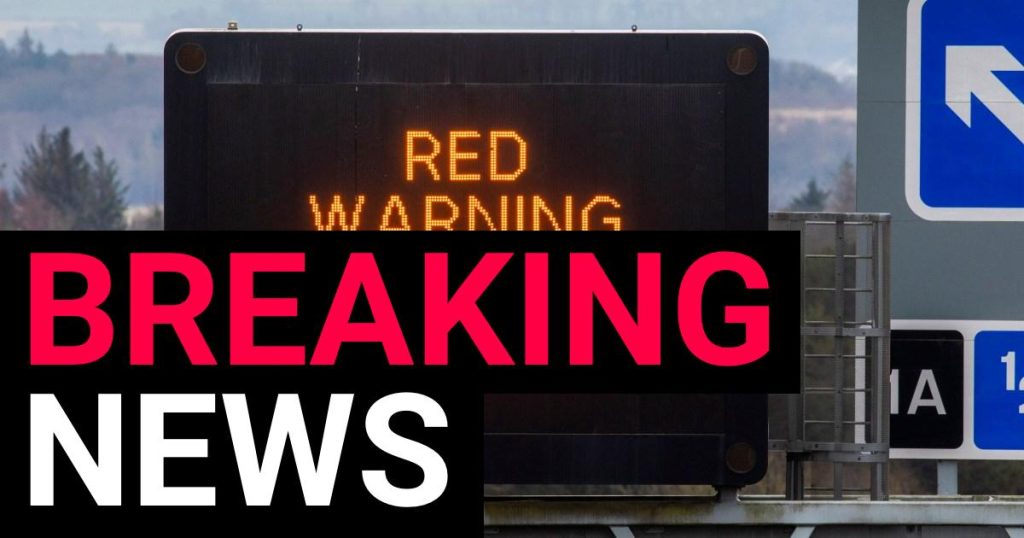Storm Eowyn Cripples UK: Red Alerts, 100mph Winds, and Widespread Disruption
Storm Eowyn has unleashed its fury upon the United Kingdom, bringing with it winds exceeding 100mph and prompting a rare red weather warning for parts of Scotland and Northern Ireland. The Met Office issued the dire warning, signifying a significant risk to life due to potential flying debris, structural damage to buildings, and downed power lines. Millions of residents have been ordered to stay indoors, with schools and businesses closed across the affected regions. The storm’s impact extends far beyond the red alert zones, with amber wind warnings blanketing much of northern England and the rest of Scotland, while yellow warnings stretch across the east and south, including London. Northern Scotland also faces snow warnings, and heavy rain is anticipated in the southwest of England, Wales, and the West Midlands.
The severity of the situation is underscored by the unprecedented use of emergency alerts. Approximately 4.5 million people in the impacted areas received alerts on their mobile phones, marking the largest real-world deployment of this emergency communication tool to date. This proactive measure emphasizes the critical nature of the storm and the imperative for residents to take precautions. The alerts advised against all but essential travel and instructed residents to remain indoors. The gravity of the situation has necessitated the suspension of all train services in Scotland, including replacement bus routes, by ScotRail and Network Rail, due to the risk of debris obstructing tracks and endangering passengers and railway staff.
Travel disruptions are widespread and impacting various modes of transportation. Ferry operators have cancelled numerous Irish Sea crossings, effectively severing connections between Britain and Ireland. British Airways has grounded over 20 flights, and additional cancellations have occurred at Glasgow, Edinburgh, and Belfast airports. The storm’s impact on road travel is equally significant, with authorities urging motorists to avoid driving unless absolutely necessary due to dangerous conditions. The combination of high winds, potential debris, and inclement weather creates a hazardous environment for all forms of travel.
The red weather warning, in effect from 7:00 AM to 2:00 PM GMT, covers the entirety of Northern Ireland and southwest Scotland, encompassing major cities like Edinburgh and Glasgow, as well as the Lothian Borders and Strathclyde regions. The Met Office has emphasized the potential danger to life, with wind gusts recorded at speeds of up to 108mph. Images of the storm’s impact are beginning to emerge, showcasing the strength of the winds and the resulting disruption to daily life. The widespread closure of schools and businesses emphasizes the seriousness of the situation and the need for residents to remain vigilant.
The unfolding crisis has prompted a coordinated response from various agencies. Police forces have reinforced the message to avoid travel in and out of the red warning areas, and transportation providers are working to mitigate the impact of the storm on their services. However, the scale and intensity of Storm Eowyn present significant challenges. The combination of high winds, heavy rain, and potential for flying debris creates a complex and dynamic threat that requires ongoing monitoring and adaptation of response strategies. The prolonged disruption to travel, particularly rail services, is expected to persist throughout the weekend, highlighting the lasting impact of this severe weather event.
The unprecedented nature of this storm underscores the importance of preparedness and the need to heed official warnings. The large-scale deployment of emergency alerts demonstrates the growing role of technology in disseminating critical information during times of crisis. As the storm continues to unfold, the focus remains on ensuring the safety of the public and minimizing disruption. The combined efforts of emergency services, transportation providers, and utility companies are crucial in navigating this challenging situation and ensuring a swift and effective recovery in the aftermath of Storm Eowyn.




